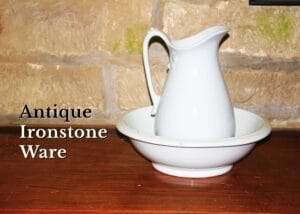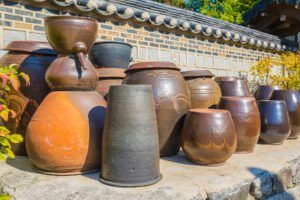When it comes to antique stoneware, most people, including collectors, often overlook those thick, heavy white dishes because they look pretty plain. But the truth is that those plain-looking dishes could actually be valuable antique ironstone worth serious money.
If you want to know tricks and tips to spot authentic antique ironstone ware and what really makes certain pieces valuable, this is the guide you need. You’ll also find a few examples of valuable ironstone at the end!
What Is Ironstone?
Typically composed of flint, Cornwall clay, and other unique ingredients, ironstone is a robust, heavy form of earthenware pottery with a smooth, white or cream finish. Despite its name, “ironstone,” it doesn’t contain iron, but is named due to its iron-like build.
The journey of ironstone started with Charles James Mason in Staffordshire, England, when he got a patent for “Mason’s Ironstone China” in 1813. It became very popular during Victorian times, as it looked like porcelain but was cheaper.
It was used on ships, in hotels, and in homes. In both England and America, it became a commonplace item of daily life and was available in either plain white or with decorative patterns. Today, authentic antique ironstone pieces are collectible for their unmatched quality.
How to Identify Authentic Antique Ironstone?
Real ironstone has some unique features that you won’t find in modern stoneware or ceramics. So, finding real antique ironstone takes more than just looking at it. You need to use your hands and eyes together to check several things.
Key Physical Features
First of all, real antique ironstone feels and looks different overall. From weight and feel to surface texture and glaze, its various physical characteristics speak a lot about its authenticity and age.
1. Weight and Feel:
The biggest clue to real antique ironstone is how heavy it feels. True antique English ironstone is quite heavy, similar to other pieces of stoneware, but with a smooth protective glaze.
A coffee cup will surprise you with its weight, and a pitcher feels really substantial. This heaviness stems from its composition.
2. Glaze and Surface:
Ironstone has a subtle shine, not the high-gloss finish of modern ceramics. The glaze is usually bright white or creamy off-white. Look for crazing, fine lines, or cracks on the surface. This isn’t damage; it’s normal aging that happens when the ceramic body and glaze expand and contract differently over time.
Also, if it’s got a slight grit under the glaze, it’s a sign of authenticity. You may also notice puddling, where the glaze is a little thicker in low areas or around the base.
3. Color:
Understanding color variations helps identify both authenticity and origin. For example, English Ironstone likely has a blueish or gray understone, which comes from the cobalt oxide in the original formula.
On the other hand, American ironstone (and newer English ironstone) generally shows a creamy (ivory-like), yellowish understone, making this an important authenticating feature!
Collector’s Tip: Carefully tap a piece with your knuckle or fingernail, and it should produce a nice ping instead of a duller, more muted sound (modern pieces).
Backstamps & Marks
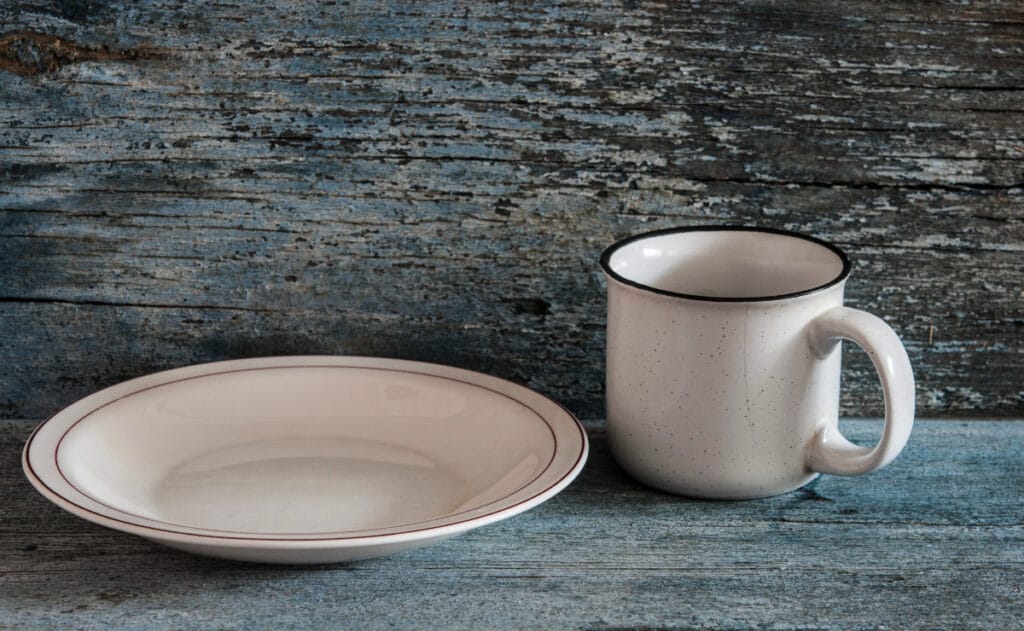
The mark on the bottom tells you the most about where and when a piece was made. These marks changed over time as companies changed hands and trade laws evolved. But many authentic pieces remain unmarked, making other identification methods crucial.
Ironstone pieces from the 1800s typically have marks on the bottom – either black stamped marks or impressed marks where the maker’s name was pressed into the clay. Impressed marks (stamped into the clay before firing) usually mean an earlier piece, while printed marks (applied over or under the glaze) became more common later in the 1800s.
Here are the different types of marks you may find on antique ironstone:
Diamond Marks (1842-1883):
You’ll find these marks on the bottom of many pieces, and sometimes on the lid undersides too. These special marks had numbers and letters placed at different points around the diamond to show what type of material it was and when the design was officially registered.
For ironstone pieces, the top of the diamond showed “Class IV” since that was the category for ceramic items.
These diamond registration marks are helpful for dating pieces because they tell you exactly when a particular design was first registered with the government.
Note: The registration number in the diamond mark is likely the date when the design was officially registered. It doesn’t necessarily denote the manufacturing date.
Registry Number Marks (1884-1991):
Later on, starting in the 1880s, a different system was used where designs got “Rd. No.” numbers instead. This numbering system started with the 1883 law about patents and trademarks and continued through various updates to design registration laws until the 1990s.
Maker’s Marks:
- Mason’s: The original maker. Look for “Mason’s” or “Mason’s Patent Ironstone China.” Early marks are often simple, impressed stamps.
- Booths: Major producer. Marks include “Booths” or “T.G.B.” and may have Royal Arms. “Royal Ironstone China” is common.
- Wedgwood: Famous for fine porcelain, but also made quality ironstone. Look for their name with “Ironstone” or “Stone China.” Their impressed “WEDGWOOD” mark is classic.
- Johnson Brothers: Known for durable, popular patterns. Marks include “Johnson Bros” and “Royal Ironstone China.” Their “Historic America” and “Old Britain Castles” patterns are highly collectible.
- Davenport: Early, influential maker. Marks include “Davenport” and “Longport.” Known for beautiful transferware on heavy stone china.
- Alfred Meakin: Prolific producer whose wares were widely exported to America. Look for “Alfred Meakin” or “Alfred Meakin Ltd.”
Warning Signs of Fake Ironstone Marks
Modern reproductions may also show similar markings, but they’re often inauthentic. For example, Victoria Ware and Iron Ware were never a thing; those names were simply created to sound legit and get people to think the piece was old.
Also, real vintage ironstone doesn’t have “Made in China” stickers, and would never be printed with something like “1890.” The date of true ironstone can sometimes be determined by the backstamp, pattern, and shape of the piece.
Another thing to note is that real marks are generally incised or made on the surface before the glazing process, so these marks don’t easily rub off. If they do, they’re fake, applied marks.
Shapes & Designs
Apart from marks, shapes can also help you date ironstone pieces. To be specific, pieces from the 1830s to the 1840s (sometimes called gothic) featured paneled, hexagonal, and even octagonal shapes in plates, pitchers, etc.
During the 1850s, leaf motifs were quite common. The 1860s to the 1880s pieces typically show highly decorative designs, including harvest motifs, wheat stalks, berries, figs, and other bulbous patterns.
Many Victorian pieces have molded, raised designs, especially on practical items like pitchers and platters. Common patterns include grapevines, wheat, or simple geometric panels. These molded designs are typical of mass-produced ironstone.
Understanding the Value of Ironstone Prices
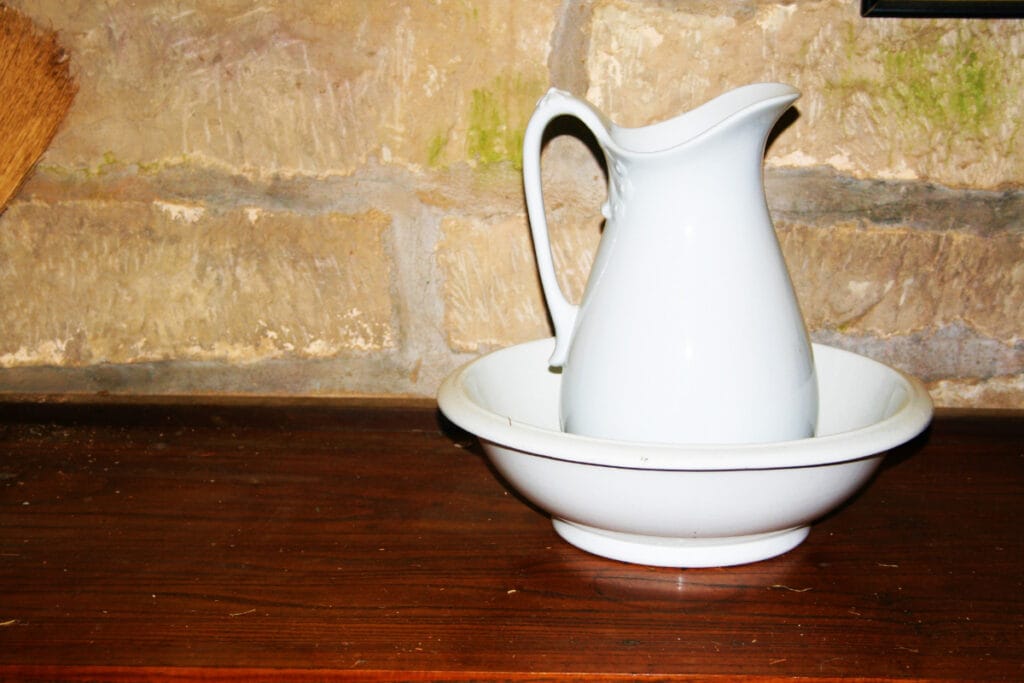
It’s worth noting that not all “authentic antique” ironstone pieces will be valuable. Some may simply be worth $15-$20, while others may reach premiums, and we’re taking thousands. To find out what value your ironstone vase, pitcher, or plate holds, you must check the following factors:
Age & Authenticity
The age of the ironstone piece has a big impact on its value. The most valuable pieces are genuinely old, often from the mid-1800s. Generally, ornate pieces are more popular, but collectors like unique plain white unadorned pieces, such as those hexagonal or octagonal pitchers or vases.
Also, ironstone pieces should be genuine to be valuable. So, make sure to verify the authenticity using marks and other features, as explained above.
Condition
The condition of old stoneware dramatically affects value, with some specific considerations for ironstone. For example, light crazing is very common in stoneware and will not drastically affect a piece’s value.
However, you must look for the following damages, as they can kill the value:
- Pieces that have pitted (the crack has gone deep beneath the glaze)
- Major chips, especially on rims and spouts
- Hairline cracks that penetrate through the body
- Missing lids on covered pieces
- Old repairs
Rarity (Form, Patterns, & Colors)
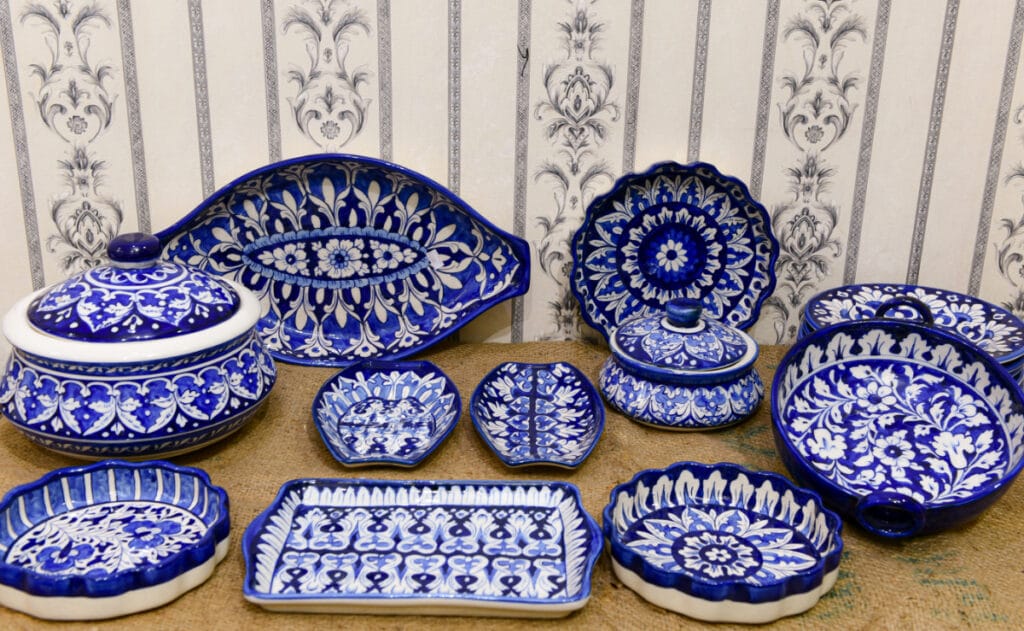
The rarer an ironstone piece, the higher it’ll be worth. And the key things that tell you whether a piece is rare or not are:
- Shapes or forms: Shapes that are rare or difficult to find today, especially in good condition, can be super valuable. So, complete items like big tureens (with lids), pitchers, large platters, or uncommon items like cake stands and punch bowls are highly wanted and bring premium prices.
- Colors: While most ironstone is white, pieces with unique transferware patterns or colors like blue or mulberry are more valuable. More elaborate pieces, such as Mason’s Imari pattern featuring many vibrant colors, also attract a lot of eyes.
- Patterns: Antique Ironstone pieces with interesting designs or painted patterns can be worth more than plain pieces. Some desirable patterns, including those with grains, flowers, and foliage (made for the agricultural communities), are Wheat and Hops, Scalloped Decagon, and Paneled Grape!
Potter’s Popularity
The name on the bottom makes a difference. Ironstone pieces from well-known makers like Mason’s or Wedgwood will almost always be more valuable than unmarked pieces or ones from lesser-known potteries. So, make sure to check for the marks!
Note: Pieces from American makers are generally valued lower than English counterparts, but are still collectible.
11 Examples of Valuable Antique Ironstone Pieces from Recent Sales
Let’s take a look at some real examples of antique ironstone pieces that actually sold for big money!
1. 19th Century Ironstone Blue Willow Serving Dish
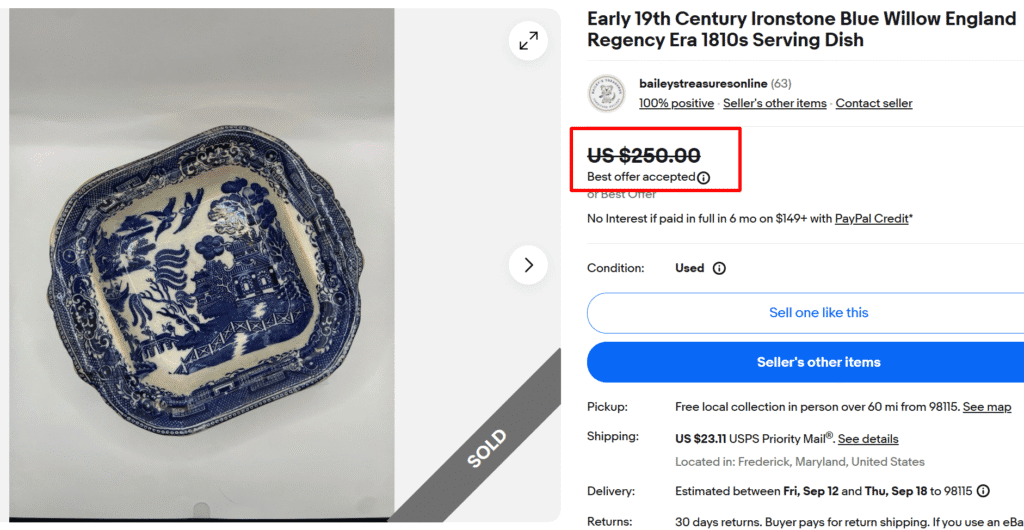
- Brand: Unknown
- Pattern: Blue Willow
- Form: Serving Dish
Blue Willow is probably one of the most recognizable china patterns ever made, first created around 1790. The pattern tells a romantic Chinese story with willow trees, a bridge, and flying birds.
This ironstone serving dish dates back to the 1810s when English potters were getting really good at blue transfer printing. Early Blue Willow pieces like this eight-sided dish tend to be worth more than newer versions. Check for a heavier weight to confirm it’s ironstone!
2. Mason’s Patent Ironstone Green Dragon Transfer Pitcher
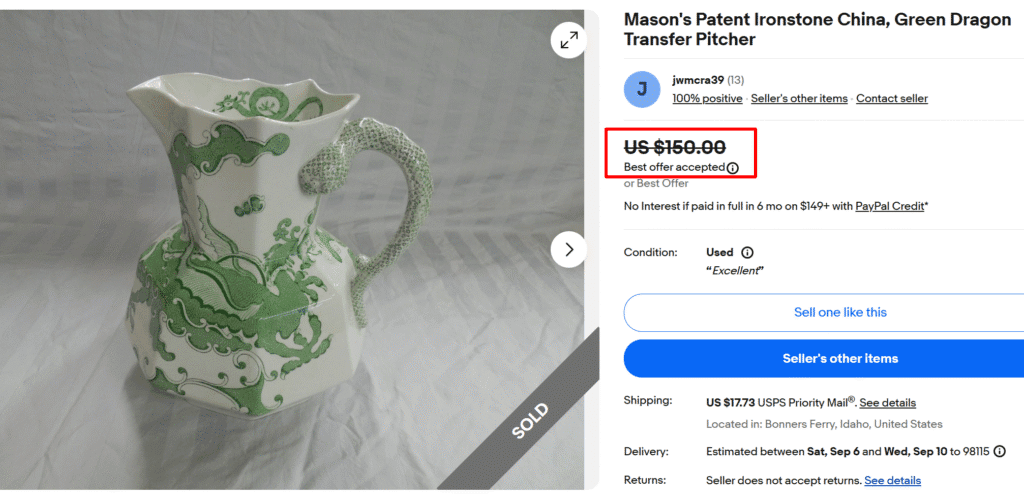
- Brand: Mason’s (Patent)
- Pattern: Green Dragon
- Form: Pitcher
This pitcher features Mason’s Chinese Dragon pattern in light green color, made around 1880. Mason’s was the company that first patented ironstone china back in 1813, and they’re known for their hexagonal and octagonal shapes and distinctive snake-like handles.
Mason’s pieces are quite popular because of their quality and eye-catching patterns. You can spot authentic pieces by Mason’s mark on the bottom.
3. Homer Laughlin White Ironstone Cake Stand
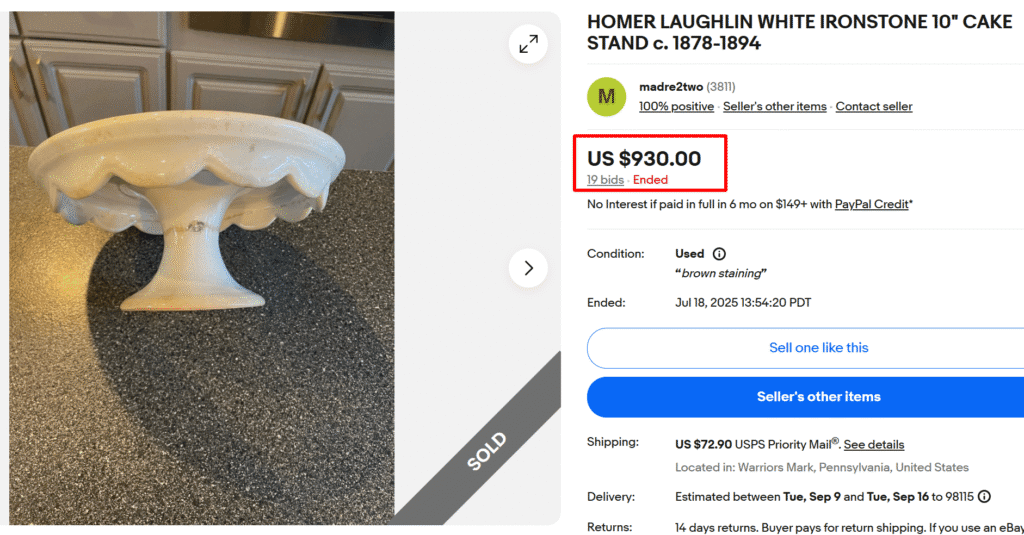
- Brand: Homer Laughlin
- Pattern: Plain White
- Form: Cake Stand
Homer Laughlin started as an American pottery company in Ohio during the 1870s. This 10-inch cake stand comes from their early days, before they became famous for making Fiesta ware. Ironstone cake stands are pretty hard to find since most have broken over the years; no wonder such pieces from big brands can fetch up to $1,200 in good condition.
4. Royal Pitcher & Basin Bowl by Alfred Meakin
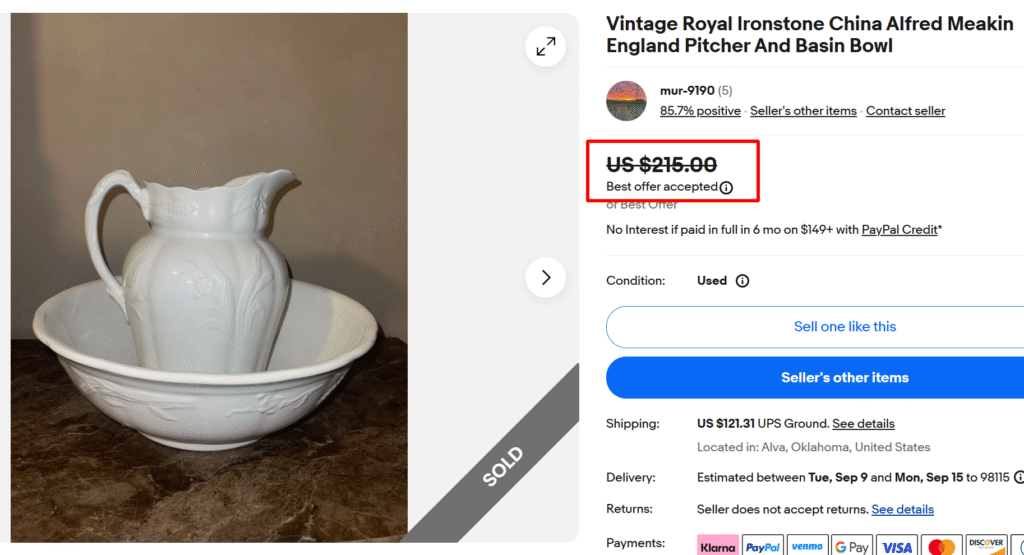
- Brand: Alfred Meakin
- Pattern: Raised Wheat & Clover
- Form: Pitcher & Basin Bowl
This washstand set comes from Alfred Meakin, a well-known Staffordshire pottery, featuring the brand’s iconic subtle raised patterns of wheat stalks and clover. Before homes had indoor plumbing, families used such ironstone pitcher and basin sets for daily washing.
You can spot genuine pieces by the Royal Ironstone mark with its crown, lion, and unicorn. Collectors like finding complete sets in nice condition!
5. Mason’s Imari Pattern Ironstone Plate
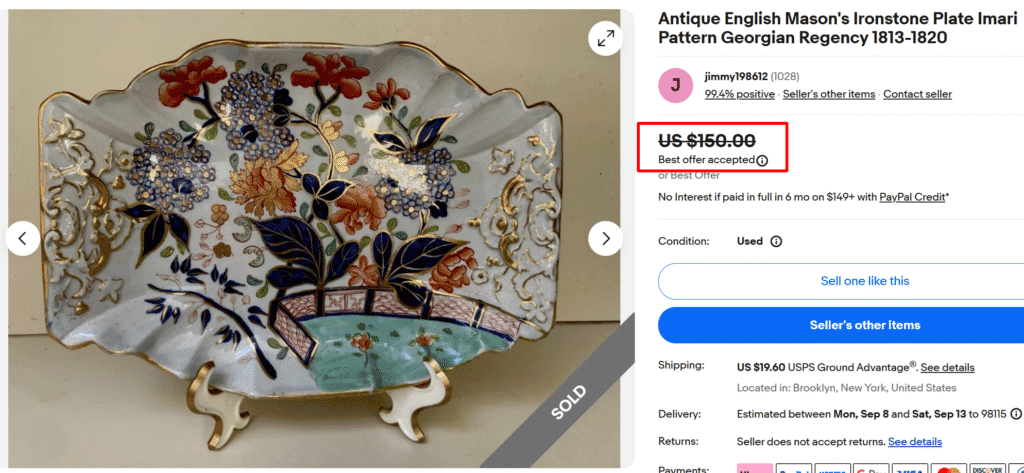
- Brand: Mason’s
- Pattern: Imari
- Form: Georgian Regency Plate
This colorful ironstone plate shows off Mason’s Imari patterns, which were inspired by Japanese designs and featured bold chinoiserie patterns in typical Imari colors. The Imari style was one of Mason’s most successful patterns.
Most Imari pieces from Mason’s feature an early impressed mark “MASONS PATENT IRONSTONE CHINA” used from 1813-1825, dating it to the Georgian period around 1820. Early Mason’s pieces from this period are fairly rare and hard to find, and are valuable.
6. Davenport English Ironstone Lidded Tureen Set
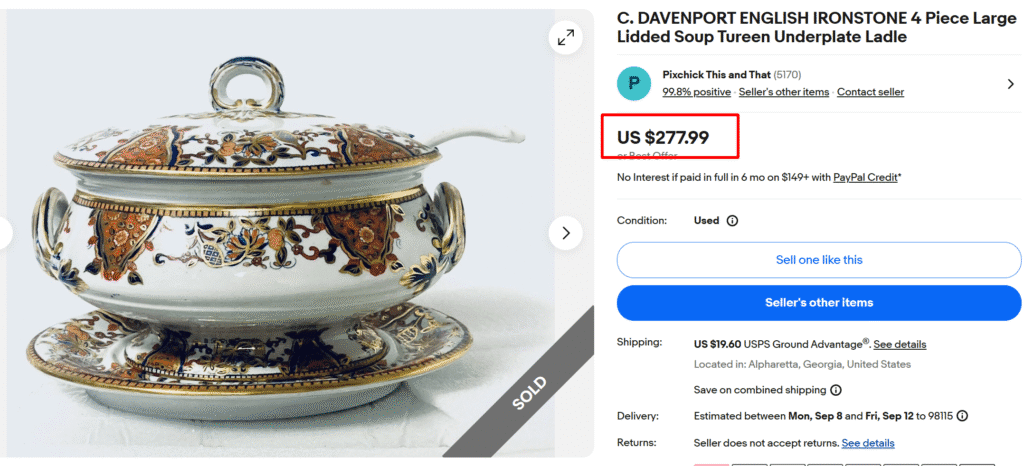
- Brand: Davenport
- Pattern: Gilded Floral Design
- Form: Soup Tureen, Underplate & Ladle Set
Ironstone tureens are a collector’s dream! And if it’s a complete four-piece set with the tureen, lid, underplate, and ladle, all featuring gilded, hand-painted floral patterns, it’s a treasure.
This set from Davenport is one such example! It has all the original components with highly decorative and often feature hand-colored Imari patterns, making it rare. While this piece sold for almost $280, some sets can even fetch up to $800 to $1,000+!
7. Davenport White Ironstone Fig Union Pitcher
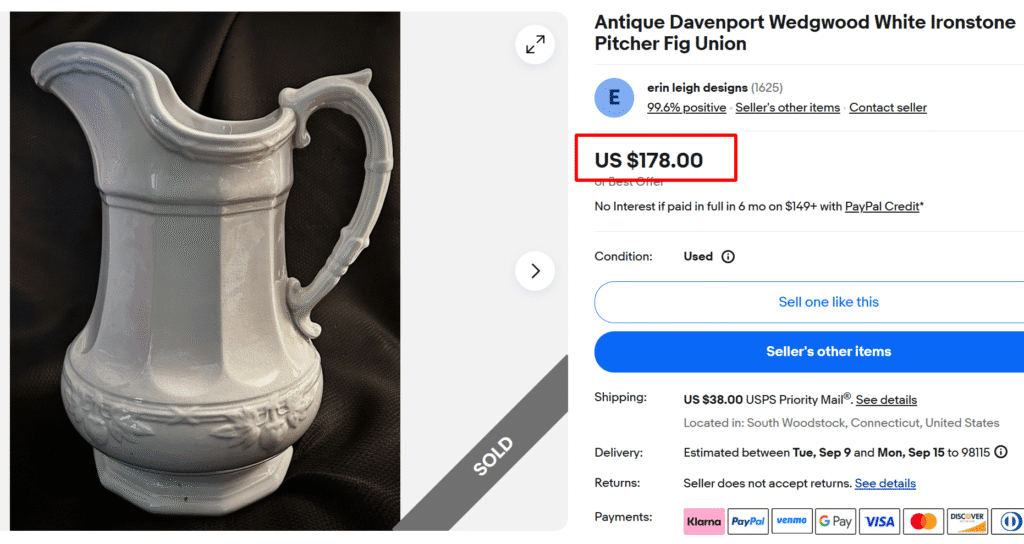
- Brand: Davenport Wedgwood
- Pattern: Fig Union
- Form: Pitcher
The Fig Union shape was registered by Davenport in 1856 and features chunky, high-relief patterns of dimensional figs flanked by leaves. The pitcher reflects the Victorian era’s make through its elaborate, molded designs.
Davenport ironstone was manufactured from 1793-1887 in Staffordshire, England. Quality pieces are well-regarded today, with such a simple white pitcher fetching over $150 to $400, showing how basic utilitarian pieces can hold a lot of value.
8. Margarine Ironstone Display Slab by Parnall & Sons
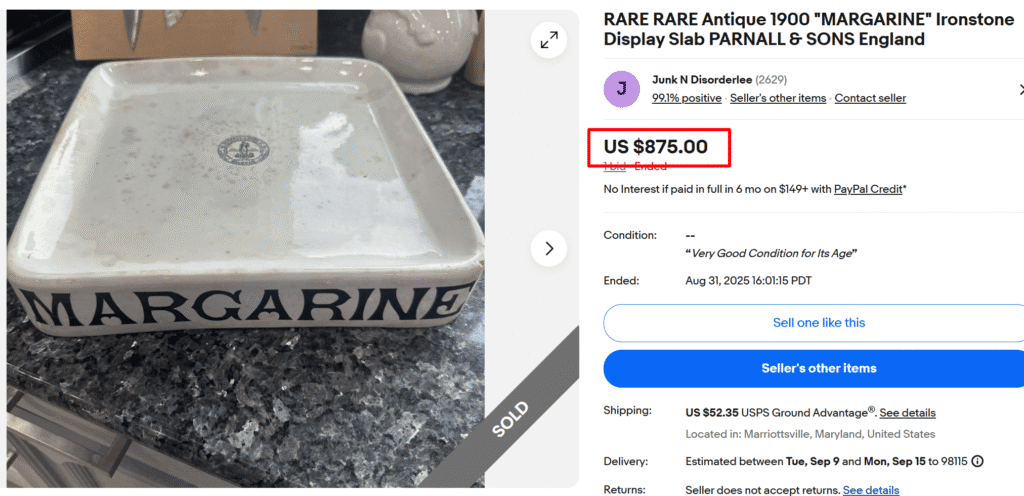
- Brand: Parnall & Sons
- Pattern: Margarine
- Form: Display Slab
This is a huge ironstone display slab made by the Parnall & Sons company of Bristol. These pieces were used in markets and grocery stores between the late 1800s and early 1900s as countertop displays.
The company released these slabs with under-glaze black transfer lettering, and they feature the company’s trapezoid advertising mark with both London and Bristol addresses. The high value for this item shows that rare pieces can be highly valuable.
9. Flying Bird Ironstone Plate by Hicks Meigh & Johnson
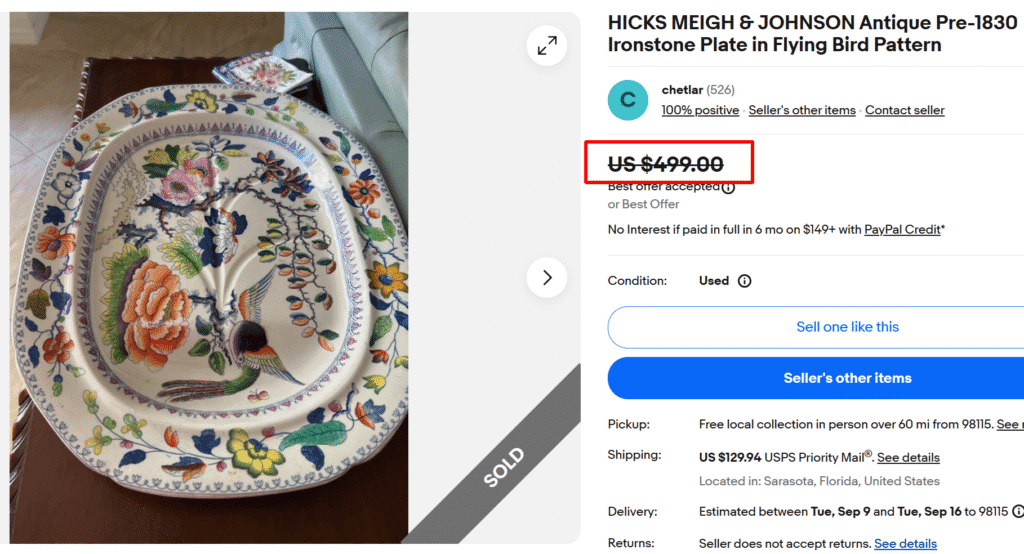
- Brand: Hicks Meigh & Johnsons
- Pattern: Flying Bird (floral motifs)
- Form: Platter/Plate
This large ironstone plate from Hicks Meigh & Johnson shows the popular Flying Bird pattern that was first introduced around 1813 and continued until about 1840. The pattern features a combination of transfer and vivid hand painting in pink, purples, yellows, greens, and orange, with gilt details added by hand.
Hicks, Meigh & Johnson operated from 1822 to 1835 and used marks like “Stone China” or “Real Stone China.” Their Flying Bird pattern is highly sought after by collectors because of its colorful design and the craftsmanship; no wonder this single plate sold for almost $500!
10. French Longjumeau Confit Ironstone Jam Pot by E. Leclerc
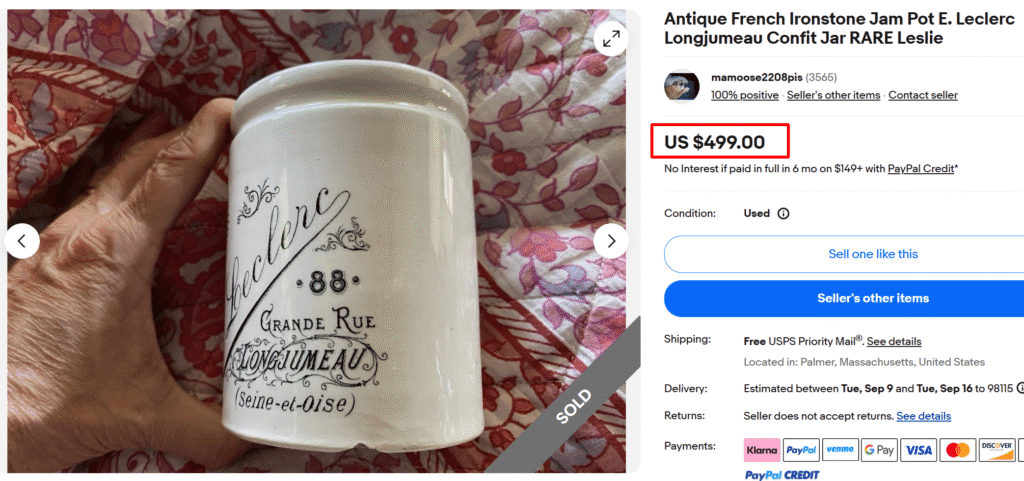
- Brand: E. Leclerc
- Pattern: Longjumeau Confit Text
- Form: Jam Pot
A small French jam pot from E. Leclerc sold for nearly $500! Why? Because this is a special piece bearing the brand’s original address “88 Grande Rue Longjumeau Seine-et-Oise,” indicating it’s from the early 1900s when Seine-et-Oise was still a department.
French confit pots like this were used by grocers and food merchants to store preserves, jams, and confits before modern packaging. These pots are highly desirable today, with pieces with clear address markings or other texts being especially valuable.
11. Heritage Hall Ironstone Dinner Set by Johnson Brothers
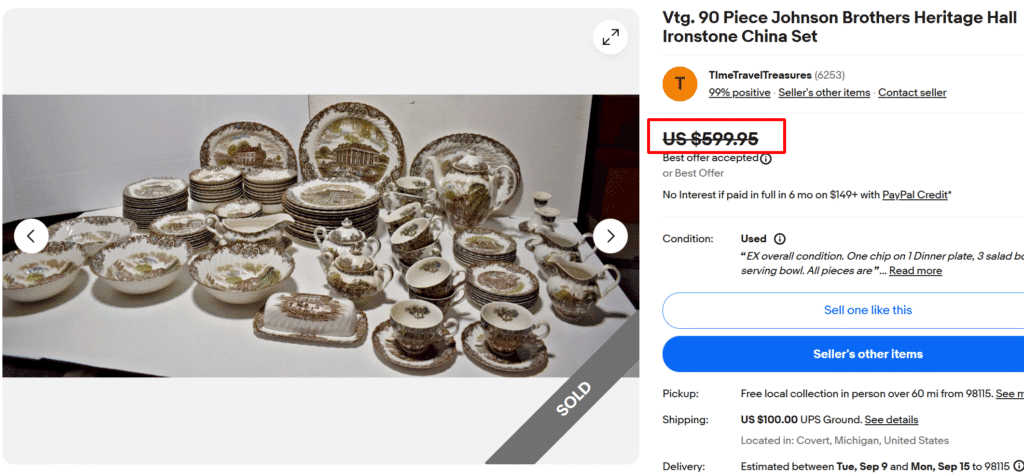
- Brand: Johnson Brothers
- Pattern: Heritage Hall
- Form: Dinner Set (90 Pieces)
This massive 90-piece ironstone set from Johnson Brothers shows one of their most iconic patterns, Heritage Hall, which was produced from 1969 to 1985. It features brown transferware scenes of American colonial buildings and homes.
Since the pattern was discontinued in 1985, making complete sets like this is increasingly sought after and worth the money.
Note: This article is intended for informational, educational, and entertainment purposes only. Some images are illustrative and may not represent actual brands, products, or related entities. All trademarks, product names, brand logos, packaging, and other intellectual property referenced remain the exclusive property of their respective owners. Any brand mentions or references are provided solely for descriptive and educational context and do not imply any formal or commercial association.

